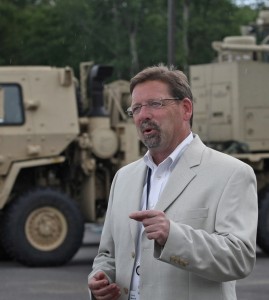Interview: Fighting for the network
These should be happy days for Chris Marzilli. Gone are the technical headaches he inherited in 2006 when he was elevated to president of General Dynamics C4 Systems. The first Army unit equipped with his company's mobile broadband network, the second increment of Warfighter Information Network-Tactical, heads to Afghanistan this summer. Then there's the wildly behind-schedule Joint Tactical Radio System. The Pentagon broke JTRS into discrete radio programs, and among the survivors were Marzilli’s IP-protocol HMS radios – short for Handheld, Manpack, Small Form Fit.
Then came the budgetary Bermuda Triangle, as Army Chief of Staff Raymond Odierno labeled the combo of the Gates spending cuts, Congress' continuing resolutions, and sequestration. The Army will need to chip in to help pay the Pentagon's war bill, and taking funds from WIN-T is being eyed as one way to do it. Marzilli spoke by phone about his company's plan to push back, and why he thinks it's no time to stop modernizing.

Chris Marzilli, president of General Dynamics C4 Systems, in front of a WIN-T node. (General Dynamics photo)
Excerpts >>
On the possibility of WIN-T cuts >> “The Army has stated their number one priority is network modernization…. Now it’s time to make sure that, in these difficult times, they actually resource the programs. And we’re making our case to hang in there.”
Sequestration and reprogramming >> “Things like reprogramming from the '13 budget that have already passed is a concern. Those are not directly related to sequester, but there’s bills to be paid because of sequester, so consequently they go after unobligated balances, investment type accounts.”
Why budget uncertainty hurts >> “Just on WIN-T and HMS, we have 228 sources of supply – critical sources of supply – nationwide. A dozen of those go out, and it jeopardizes the ability to actually get this stuff to the fight.”
No shame in lobbying >> “We’re educating our delegation, and we spend a lot of time and energy doing that. It’s good. It’s part of the job.”
Don’t stop modernizing now >> “The programs of record that are graduating are bringing dramatic game-changing technology, and SOF (special operations forces) will be some of the first to get that. In fact…the 10th Mountain and the 101st are the elite, SOF-type forces of the Army, and will be the first receivers and deployers for WIN-T Increment 2 and HMS.”
Big satcom project on track >> “So much attention was applied to the fact that they had a gap between the two big programs of record, the former JTRS program and the MUOS (Mobile User Objective System satellite) program, that we were set to work on filling the gaps. Now our terminals are ahead of the constellation, which is a real rarity.”
Connection to homeland >> (Army Lt. Gen. James O. Barclay) was actually testifying on the compelling need to keep the soldier’s network fresh and deployed….The Army WIN-T network is absolutely pivotal to the homeland security network and the threats to the homeland, because of its connectiveness to the National Guard.”
HMS explained >> “The radio is like a cell tower. It sits on his hip. It’s his infrastructure because there is no cell tower in the places where they typically deploy your expeditionary forces. So the HMS is the surrogate cell tower, and then the Manpack is the router, if you will, that bridges that local cell tower at the soldier radio waveform level back into that Army WIN-T network.”
Trapped in “voice land” >> “(Soldiers are) a template for the public safety folks who are still trapped in voice land, because it’s all they’ve ever known…. Most of the traffic that runs over the Army’s network is data traffic. And all of the voice is voice over IP, so even the voice is data.”
Does a smartphone threaten a radio? >>
“It’s a threat to LMR (land mobile radio) radios on U.S. soil, because again those are narrowband and limited. They’re pretty much voice instruments and instruments of the past. But it’s not a threat to an HMS radio, because again the radio isn’t a voice instrument. It’s actually a cell tower.”
FirstNet cell network vs. radios. >>
“Our role is to bridge (radios and smartphones), because they’re not going to rip and replace their LMR networks today. Those are all they have, and you don’t miraculously show up with a $20 billion FirstNet network.”


